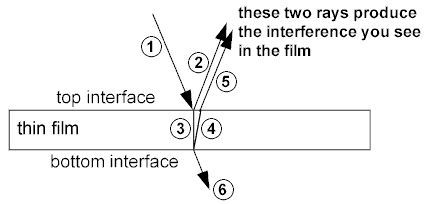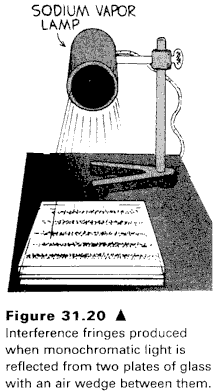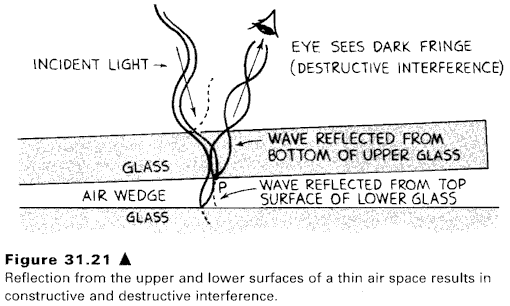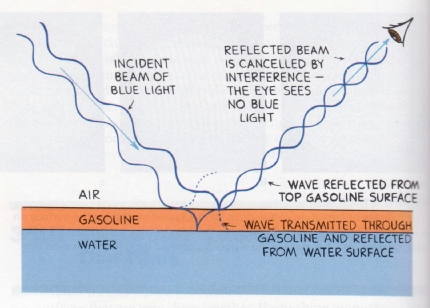31.5 Single-Color Interference from Thin Films
Interference fringes can be produced by the reflection of light from two surfaces that are very close together. Below is a diagram of a thin film and the light rays associated with the reflections and refractions as light impinges on the film. When ray 1 strikes the top interface, some of the light is partially reflected, ray 2, and the rest is refracted, ray 3. When ray 3 strikes the bottom interface, some of it is reflected, ray 4, and the remainder is refracted, ray 6. When ray 4 strikes the top interface from underneath, some is reflected (not shown) and some is refracted, ray 5. It is interference between rays 2 and 5 that produce the thin film's color when the film is viewed from above.
If you shine monochromatic light onto two plates of glass, one atop the other as shown in Figure 31.20, you’ll see dark and bright bands. The cause of these bands is the interference between the waves reflected from the glass on the top and bottom surfaces of the air space between the plates. This is shown in Figure 31.21. The reflected light comes to the eye by two different paths. The light that hits the lower glass surface has slightly farther to go to reach your eye. If this extra distance results in light from the upper and lower reflections getting to your eye one-half wavelength out of phase, then destructive interference will occur and a dark region will be seen. Nearby, the path differences will not result in destructive interference, and a light region will be seen
A practical use of interference fringes is the testing of precision lenses. When a lens to be tested is placed on a perfectly flat piece of glass and illuminated from above with monochromatic light, light and dark fringes are seen (Figure 31.22). Irregular fringes indicate an irregular surface. When a lens is polished until smooth and concentric, the interference fringes will be concentric and regularly spaced.
Figure 31.22
The flatness or curvature of a surface can be tested by placing the surface on a very flat piece of glass and observing the interference pattern.
(a) an irregular surface; (b) a flat surface;
(c) a poorly polished lens; (d) a precision lens.
31.6 Iridescence from Thin FilmsEveryone who has seen soap bubbles or gasoline spilled on a wet street has noticed the beautiful spectrum of colors reflected from them. Some types of bird feathers have colors that seem to change hue as the bird moves. All these colors are produced by the interference of light waves of mixed frequencies in thin films, a phenomenon known as iridescence.
A thin film, such as a soap bubble, has two closely spaced surfaces. Light that reflects from one surface may cancel light that reflects from the other surface. For example, the film may be just the right thickness in one place to cause the destructive interference of, say, blue light. If the film is illuminated with white light, then the light that reflects to your eye will have no blue in it. What happens when blue is taken away from white light? The answer is, the complementary color will appear. And for the cancellation of blue, we get yellow. So the soap bubble will appear yellow wherever blue is canceled. In a thicker part of the film, where green is canceled, the bubble will appear magenta. The different colors correspond to the cancellations of their complementary colors by different thicknesses of the film. (color addition video)
Image courtesy of Conan the Bubbleman
Let's examine the interference for a thin layer of gasoline on a layer of water. Light reflects from both the upper gasoline-air surface and the lower gasoline-water surface. Suppose that the incident beam is monochromatic blue, as in the illustration. If the gasoline layer is just the right thickness to cause cancellation of light of that wavelength, then the gasoline surface appears dark to the eye. On the other hand, if the incident beam is white sunlight, the gasoline surface appears yellow to the eye. Blue is subtracted from the white, leaving the complementary color, yellow.
Figure 21.23
Image courtesy of Nature's Maths
The beautiful colors of gasoline on a wet street correspond to different thicknesses of the thin film. The colors provide a vivid “con tour map” of microscopic differences in surface “elevations.”
Figure 21.24
The thin film of gasoline is just the right thickness so that mono chromatic blue light reflected from the top surface of the gasoline is canceled by light of the same wavelength reflected from the water.The beautiful colors reflected from some types of seashells are produced by interference of light from their thin transparent coatings. So are the sparkling colors from fractures within opals. Interference colors can even be seen in the thin film of detergent left when dishes are not properly rinsed.
1. What is iridescence and what phenomena is it related to?
2. How can interference fringes indicate whether a piece of glass is perfectly flat?
3. If a soap bubble is thick enough to cancel yellow by interference, what color will it appear if illuminated by white light?
4. If a soap bubble is thick enough to cancel red by interference, what color will it appear if illuminated by white light?
5. Why is gasoline that is spilled on a wet surface so colorful?






